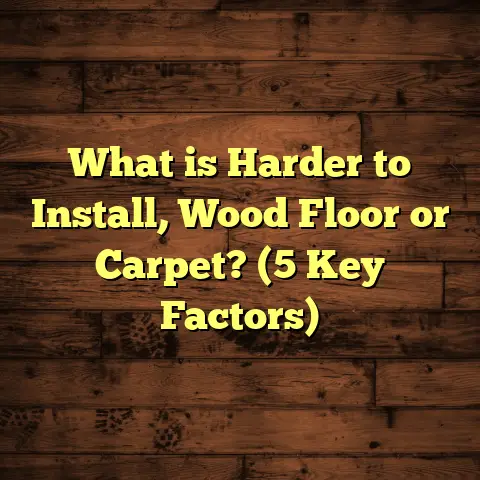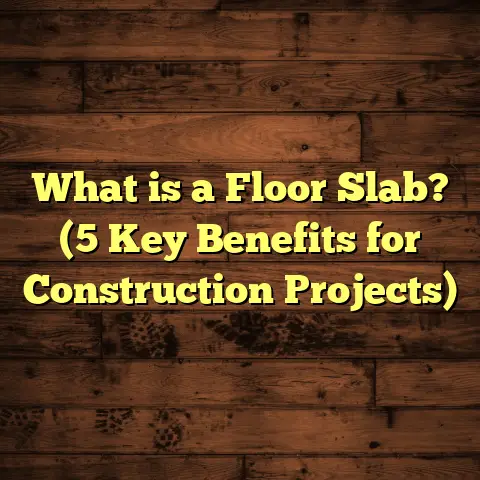What is the Ground Floor Label in Mexico? (5 Key Insights Revealed)
I once made a pretty big mistake when I first started working on a project involving Mexican buildings. I assumed the “ground floor” was the same everywhere—like it is in the U.S. or Canada. But boy, was I wrong! When I learned about the ground floor label in Mexico, I realized there’s a whole different system that could confuse anyone unfamiliar with the culture and language. If you’re planning to buy, rent, or renovate property in Mexico, understanding this is super important.
What is the Ground Floor Label in Mexico?
So let me explain: in Mexico, when someone says “planta baja,” they are referring to what English speakers call the “ground floor.” However, unlike in the U.S., where the ground floor is usually labeled as “1” or “first floor,” in Mexico, the planta baja is considered floor zero.
This means that the floor above planta baja is called “primer piso,” or first floor, which can be confusing if you’re used to thinking the ground level is already the first floor. So if you’re told an apartment is on the primer piso in Mexico, it’s actually one level above street level.
The reasoning behind this labeling system has historical roots going back to European influences, particularly Spain, where the same system applies. This difference affects everything from real estate listings to construction plans and even emergency instructions.
Precise Measurements and Typical Layouts
In most Mexican homes and buildings, the planta baja (ground floor) typically includes:
- The main entrance
- Living room or sala
- Dining area
- Kitchen
- Sometimes a half bathroom or guest bathroom
The height of each planta baja can vary but usually ranges between 2.5 to 3 meters (about 8 to 10 feet). This height is comfortable enough for ventilation and natural light, especially since many Mexican homes incorporate open courtyards or patios on this level.
From my experience working on projects in Mexico City and Guadalajara, I noticed that planta baja spaces tend to prioritize social areas over bedrooms. Bedrooms are often located on the upper floors (primer piso and above).
Costs and Timeframes for Ground Floor Construction
If you’re curious about costs, building or renovating a planta baja in Mexico can vary widely depending on location, materials, and labor. For example:
- In Mexico City, construction costs for residential buildings can range from $6,000 to $12,000 MXN per square meter (approximately $300 to $600 USD per square meter).
- In smaller cities or rural areas like Oaxaca or Puebla, prices may be lower by 20% to 40%.
For a typical 100-square-meter planta baja, you might expect to pay anywhere from $600,000 to $1,200,000 MXN ($30,000-$60,000 USD) for a complete build including finishes.
Timeframes also matter. Constructing a planta baja usually takes about 4 to 6 months if you hire local contractors experienced with Mexican building codes and materials. Delays can happen due to weather (rainy season), permit processing, or supply chain issues.
Why Understanding “Planta Baja” is More Than Just Semantics
Let me share a story. A few years ago, I helped a friend find an apartment in Guadalajara. He wanted a ground-floor unit because he’d just had knee surgery and stairs were difficult. We found a listing for a “departamento en primer piso” which he assumed was ground-level.
When we visited the place, it was actually one flight up—no elevator—and he was stuck climbing stairs anyway. It was frustrating but also eye-opening for me as a contractor who thought I knew these terms well.
It’s this kind of detail that can save you time and headaches.
Real Estate Listings Can Be Confusing
If you’re searching online for apartments or houses in Mexico, pay close attention to how floors are labeled.
- Planta Baja = Ground floor (street level)
- Primer Piso = First floor (one level above ground)
- Segundo Piso = Second floor (two levels above ground), and so on.
Sometimes listings will use abbreviations like P.B. for planta baja or just say “bajo” meaning lower level.
Prices can also differ by floor. Ground floor units may cost less than upper floors due to noise or security concerns but might offer better access or outdoor space like patios or gardens.
How This Affects Renovations and Building Projects
When I work on flooring installations or renovations in Mexico, knowing exactly which floor I’m dealing with is critical. For example:
- Moisture concerns are different on planta baja because it’s closer to the ground and might have higher humidity levels.
- Structural support may vary; ground floors often have thicker concrete slabs and different foundation requirements.
- Electrical and plumbing layouts are planned differently depending on which floor you’re working on.
Getting these details mixed up can cause delays or require rework.
Flooring Insights for Planta Baja: What Works Best?
When working with clients in Mexico, I always remind them that flooring choices on planta baja should consider factors like humidity and foot traffic:
- Ceramic tiles are popular on ground floors because they handle moisture well and are easy to clean.
- Concrete floors with a polished finish are also common and budget-friendly.
- Hardwood floors are less common on planta baja due to humidity but can work well with proper sealing.
In humid coastal cities like Veracruz or Cancun, choosing moisture-resistant flooring on planta baja is crucial because ground floors are more exposed to dampness.
Personal Experience With Flooring Choices
One project I worked on in Mérida had constant issues with mold under hardwood floors on planta baja units because of the tropical climate. After switching to high-quality ceramic tiles with anti-slip finishes, those problems disappeared.
On the other hand, in Mexico City’s drier climate, some clients prefer engineered wood floors on planta baja for warmth and style—they just need good sealing against occasional humidity.
Local Building Codes and Regulations Impacting Planta Baja
I’ve found that understanding local regulations is key when working with planta baja spaces. Each Mexican state has its own building codes but most follow general national standards set by the Secretaría de Desarrollo Agrario, Territorial y Urbano (SEDATU).
These codes regulate:
- Minimum ceiling heights (usually 2.5 meters for residential)
- Structural load requirements
- Fire safety measures including exit routes from planta baja
- Electrical grounding and plumbing installations
Ignoring these rules can result in fines or the need to undo work — something I always warn clients about.
Case Study: A Renovation in Monterrey
A client wanted to convert their planta baja living room into a commercial space (small café). The city required them to:
- Install emergency exits clearly marked from planta baja
- Use fire-resistant flooring materials
- Upgrade electrical wiring to commercial standards
This added 15% to their budget but kept the project legal and safe.
How Does Cultural Context Influence Ground Floor Usage?
In Mexico, homes aren’t just buildings—they’re family hubs. Planta baja is often where families gather to cook, eat, chat, and entertain guests. It’s common for extended families to live together with multiple generations sharing different floors.
Courtyards and Patios: A Signature Feature
Many Mexican homes include an interior courtyard (patio) accessible from planta baja. These patios act as natural light wells and help ventilate rooms—very important given Mexico’s climate variety.
I remember working on a project in San Miguel de Allende where the client insisted on restoring an original colonial-style patio connected directly to planta baja. The space became a stunning centerpiece with hand-painted tiles and native plants.
Outdoor Flooring Options for Planta Baja Patios
If you have a patio connected to your planta baja:
- Consider terracotta tiles or natural stone for authentic look and durability
- Use slip-resistant finishes since patios can get wet during rainy season
- Plan drainage carefully—water pooling can damage floors over time
Detailed Data: Construction Trends Regarding Planta Baja Floors
According to INEGI data from 2023:
- Over 40% of new urban housing developments in Mexico include two or more floors.
- Of those multi-story houses/apartments, approximately 65% allocate social spaces (living room/kitchen) on planta baja while bedrooms go upstairs.
- Average size of planta baja units ranges from 70 m² in urban apartments up to 150 m² in suburban houses.
Cost Breakdown for Flooring Installation on Planta Baja
Based on data from multiple projects across Mexico City:
| Flooring Type | Cost per m² (MXN) | Installation Time (hrs/m²) | Durability Rating (1–10) |
|---|---|---|---|
| Ceramic Tiles | 300 – 450 | 1 – 2 | 9 |
| Polished Concrete | 250 – 400 | 0.5 – 1 | 8 |
| Engineered Hardwood | 700 – 1,200 | 2 – 3 | 7 |
| Natural Stone | 900 – 1,500 | 3 – 4 | 10 |
Installation time depends heavily on substrate preparation and finishing preferences.
Personal Tips for Anyone Dealing with Planta Baja Floors in Mexico
- Never assume “ground floor” means floor #1: Always ask how locals label floors before making decisions.
- Check humidity levels: This affects your choice of flooring material.
- Consider foot traffic: Planta baja often sees more visitors; durability matters.
- Ask about local labor rates: Skilled labor costs vary widely—urban areas tend to be pricier.
- Get detailed quotes including waste factor: It’s common for contractors here to order extra materials for cuts/spills — usually add around 10%.
Final Thoughts From My Experience
If you ever find yourself involved with Mexican real estate—whether buying, renting, or renovating—don’t take labels at face value. Ask for clarifications about plantas bajas and pisos. Think of it like learning a new language; these small differences can change your entire experience.
And when it comes to flooring on planta baja? Choose materials that suit your climate and lifestyle. Ask locals or contractors about what works best because they often have firsthand knowledge of what lasts through seasons and daily wear.
So next time you see “planta baja” on a listing or blueprint in Mexico, remember—it’s not just the ground floor; it’s floor zero with its own character and importance. Keeping this in mind will save you from surprises and help you make smarter decisions for your home or project.





